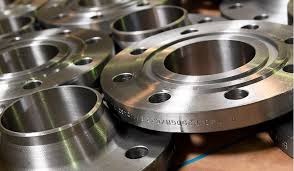Introduction
In Piping and Tubing, flanges are the very vital components or connectors, which are mostly used in various industries. Nascent Pipe & Tubes is proud to be manufacturing and supplying high-quality flanges that one would not hesitate to introduce to the most stringent modern-day engineering projects. Below is a detailed guideline about the different types of flanges, their application, and flanges benefits in the railway industry.

Understanding Flanges
In the simplest of terms, the pipe flanges are the mechanical device that deals with the connection of the pipes, with the valves, pumps, and other pieces of equipment, thus completing the piping system. They offer easy access to clean, inspect, and make modifications. Flanges usually have three common components: a gasket, bolts, and some nuts. More so, the above components work jointly to comprise a tight and leakage-preventing connection.
Flange Types:
1. Weld Neck Flanges
The weld neck flanges are made in designs where they attach to the pipe by welding. The type will, therefore, work well under high pressure since it will manage to offer steady and secure connections. The neck distributes stress to the flange, therefore minimizing the chances of failure.
2. Slip on Flanges
Slip-on flanges are quite easier to perform because they lean on the pipe being installed. It works efficiently under low-pressure applications and has found major use in many industries where economic advantage and swiftness are key factors.
3. Blind Flanges
Blind flanges are used for closing the end of pipes, valves, or pressure vessel openings. They are important for maintenance and repair works because the plate, designed to block the flow in the flange, may be removed to afford easy access to the piping system without destroying the fab structure.
4. Socket Weld Flanges
Socket weld flanges are used only for small-diameter, high-pressure pipes where the insertion of the pipe into the socket end provides welding around the top, ensuring it is leak-proof in service and gives additional strength to the joint.
5. Lap Joint Flanges
These are used with stub-end fittings. Lap flanges are most commonly used in systems where frequent disassembly may be required for inspection, as they offer flexibility and ease of maintenance.
6. Threaded Flanges
The threaded flanges are screwed onto the pipe without welding, especially for applications where welding is not possible or practical. They are used in low-pressure and non-critical services.
Applications of Flanges in Railways
Flanges are very critical to the railway industry because they ensure all the systems work not only safely but also efficiently. Nascent Pipe & Tubes provides engineered flanges that can experience the following or more rigors designed for applications on railways:
- Fuel Systems: Fuel is a highly developing connector application through flanges to unite the components of fuel delivery systems and assure leak-proof and struggle-safe connection.
- Hydraulic Systems: For hydraulic systems, flanges are used to attach pipes and hoses to ensure that the movement of fluids is proper by controlling the obtained pressure.
- Flange Cooling Systems: These are used to connect pipes carrying coolant in cooling systems as a means of maintaining working temperature.
- Brake Systems: In railway brake systems, flanges ensure secure connections for air and hydraulic lines that are extremely important for safety and performance.
Benefits of Using High-Quality Flanges:
1.Reliability and Safety
Flanges of high quality assure reliable and secure connection with a minimum risk of leaking and less chance of failure. That is most arguably useful in high-pressure and critical applications that happen from the railway.
2.Durability
The flanges from Nascent Pipe & Tubes are all fabricated from high-grade raw material that further ensures their durability and resistance to wearing out easily. This turns out to be cost-effective avoiding high induction of maintenance costs and extending its lifespan.
3. Ease of Maintenance
Flanges provide easy access for inspection, cleaning, and maintenance. Proper ease of accessibility at flanges is very important for the piping system to remain soil-free for continuity of operations.
4. Versatility
The availability of different kinds of flanges makes them find a huge range of uses and applications in various industries. Their diverse composition and types are what make them so valued in any type of piping system.
Reasons to Choose Nascent Pipe & Tubes for Your Flange Requirements
Nascent Pipe & Tubes is one of the outstanding manufacturers and suppliers of Flanges, which offers a comprehensive range of product for all customer needs. Quality, Innovation, and customer satisfaction have become the guiding light of our company. We realize the unique demands of the railway industry, and we provide the flanges that offer the best performance together with safe use.
Key Features of Our Flanges:
- Manufactured using high-quality materials
- Comes in different sizes and specifications
- Designed for durability and reliability
- Solutions that are cost-effective for all applications
Conclusion
A piping system cannot be complete without the use of flanges, just like in most industries, railways are no exception. Knowledge of flanges and their different types and applications pays off when choosing a product based on individual needs. Nascent Pipe & Tubes is committed to providing top-quality flanges that result in safety and efficiency in each application. Contact us today if you have any questions or need assistance with your flange requirements.
